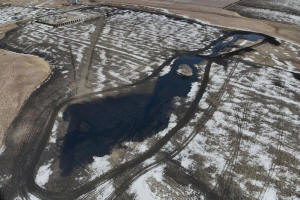Cleanup underway of the Keystone oil pipeline spill in North Dakota
[April 10, 2025]
By JACK DURA
BISMARCK, N.D. (AP) — Trucks and workers started cleaning up the
Keystone oil pipeline spill in rural North Dakota, though its cause and
the project timing is unclear.
The pipeline ruptured Tuesday morning in southeastern North Dakota and
was shut down within two minutes by an employee who heard a mechanical
bang. An aerial photo released Wednesday shows a black, pondlike pool of
oil suspended in a partially snowy field that's traversed by tire
tracks.
A farmer told The Associated Press he could smell the scent of crude
oil, carried by the wind.
South Bow, a liquid pipelines business that manages the pipeline,
estimated the spill's volume at 3,500 barrels, or 147,000 gallons.
Keystone's entire system remains shut down.
What caused the spill?
That's not yet known. The company is investigating what caused the spill
and how long repairs might take, spokesperson Kristin Anderson said
Wednesday.
The spill is not a minor one, said Paul Blackburn, a policy analyst with
Bold Alliance, an environmental and landowners group that fought the
pipeline's extension, called Keystone XL.
The estimated volume of 3,500 barrels, or 147,000 gallons of crude oil,
is equal to 16 tanker trucks of oil, he said. That estimate could
increase over time, he added.

Blackburn said the bigger picture is what he called the Keystone
Pipeline's history of spills at a higher rate than other pipelines. He
compared Keystone to the Dakota Access oil pipeline since the latter
came online in June 2017. In that period, Keystone's system has spilled
nearly 1.2 million gallons (4.5 million liters) of oil, while Dakota
Access spilled 1,282 gallons (4,853 liters), Blackburn said.
In its update, the company said the pipeline “was operating within its
design and regulatory approval requirements at the time of the
incident.”
Generally, underground oil pipelines can have a number of stressors,
said Ramanan Krishnamoorti, vice president for energy and innovation at
the University of Houston.
Those include corrosive elements from the liquid within the pipeline,
changing temperatures, moving soil, movement from trains or construction
equipment on the surface and stress to bends, turns and joints in the
pipeline, he said.
The 2,700-mile (4,350-kilometer) pipeline originates in Alberta, Canada,
and carries heavy tar sands crude oil south across the Dakotas and
Nebraska before splitting to carry oil both to refineries in Illinois
and south to Oklahoma and Texas.
The $5.2 billion Keystone Pipeline was built in 2010. TC Energy built
the pipeline which is operated by South Bow as of last year.

How has the company responded?
The spill is contained to an agricultural field. In an update Wednesday,
South Bow said it has multiple on-site vacuum trucks beginning to
recover the oil. Continuous air quality monitoring is underway. The
pipeline's affected segment is isolated, and the company said it's
evaluating plans for a return to service.
Phone messages and emails were left Wednesday with the state Department
of Environmental Quality and the Ransom County sheriff about the spill
and response.
[to top of second column]
|

This image provided by South Bow shows a spill from the Keystone oil
pipeline that occurred Tuesday, April 8, 2025 near Fort Ransom, N.D.
(South Bow via AP)

Myron Hammer, an adjacent landowner who farms the land affected by the
spill, said it hasn’t yet adversely affected him, aside from the smell
of crude oil or sulfur carrying when the wind blows in a certain
direction. The pipeline company appears to be doing its due diligence to
fix the problem, he said.
There’s been a lot of truck traffic bringing equipment to the scene, he
said. His house is about 1.75 miles (2.82 kilometers) away.
“It’s become a beehive of activity in the proximity there,” Hammer said.
Some of his property is being used as a staging area for equipment. He
said he'll have to cancel plans to farm on roughly 5 or more acres of
land impacted by the spill.
The spill site is north of Fort Ransom, a tiny town in a hilly, forested
area known for scenic views and outdoor recreation. A state park and
hiking trails are nearby.
The rupture in North Dakota occurred within 2 1/2 years of a December
2022 rupture in rural northeastern Kansas that dumped about 13,000
barrels of crude oil into a creek. The company attributed the rupture to
a faulty weld in a pipe bend, saying it caused a crack that grew over
time under stress.
A report drafted by an outside engineering consulting firm for U.S.
government regulators later said the bend had been “overstressed” since
its installation in December 2010, likely because construction activity
itself altered the land around the pipe. A July 2021 report by the U.S.
Government Accountability Office said the four biggest previous spills
on the Keystone system were caused by issues tied to its original
design, its construction or the manufacturing of the pipe.

Will gas prices increase?
They very well might, though energy experts have different outlooks.
The pipeline's shutdown could quickly raise gas prices in the Midwest
and could have more effects on diesel and jet fuel because refineries
will have less of the crude oil they need, Krishnamoorti said.
Higher-priced diesel could lead to higher grocery prices because diesel
trucks transport those products, he said.
Other experts said the refineries likely have a supply of crude oil
already on hand that would help protect against immediate impacts of the
shutdown.
“Even if the pipeline gets cut off completely for, say, 2 or 3 weeks,
they have enough crude (oil) to continue refining for gasoline,” said
Mark LaCour, editor-in-chief of the Oil and Gas Global Network.
Gas prices increased for a third consecutive week in the U.S., but that
could change as oil prices drop amid the escalating global trade war.
___
Associated Press writer John Hanna contributed from Topeka, Kansas.
All contents © copyright 2025 Associated Press. All rights reserved
 |